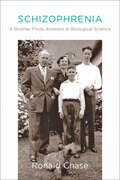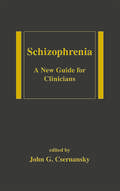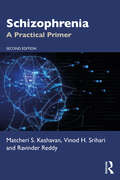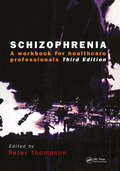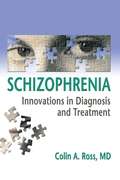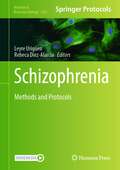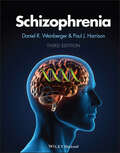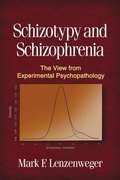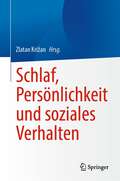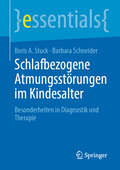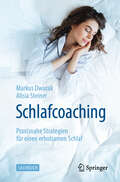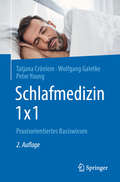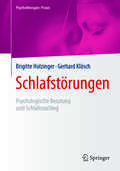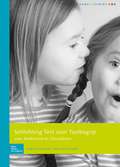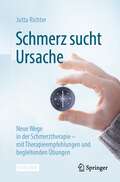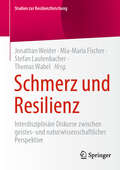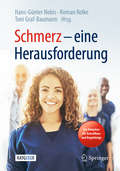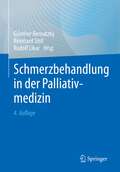- Table View
- List View
Schizophrenia: A Brother Finds Answers in Biological Science
by Ronald ChaseA neuroscientist explores the biological bases of schizophrenia and tells the heartbreaking story of his own brother’s battle with the disease.When bright lives are derailed by schizophrenia, bewildered and anxious families struggle to help, and to cope, even as scientists search for causes and treatments that prove elusive. Painful and often misunderstood, schizophrenia profoundly affects people who have the disease and their loved ones. Here Ronald Chase, an accomplished biologist, sets out to discover the facts about the disease and better understand what happened to his older brother, Jim, who developed schizophrenia as a young adult.Chase’s account alternates between a fiercely loyal and honest memoir and rigorous scientific exploration. He finds scientific answers to deeply personal questions about the course of his brother’s illness. He describes psychiatric practice from the 1950s—when electroconvulsive shock therapy was common and the use of antipsychotic medications was in its infancy—to the development of newer treatments in the 1990s. Current medical and scientific research increases our understanding of genetic and environmental causes of the disease.Chase also explores the stigma of mental illness, the evolution of schizophrenia, the paradox of its persistence despite low reproduction rates in persons with the disease, and the human stories behind death statistics. With the author’s intimate knowledge of the suffering caused by this disease, Schizophrenia emphasizes research strategies, the importance of sound scientific approaches, and the challenges that remain.“A rare combination of family memoir and accessible explanation of the neuroscience, genetics, and the epidemiology of schizophrenia. I simply love this book.” —Patrick Tracey, PsychCentral
Schizophrenia: A New Guide for Clinicians (Medical Psychiatry Series)
by John G. CsernanskyContains guidelines and recommendations-in tabular form for quick reference-on patient evaluation and optimal treatment for long-term care!Based on evidence from recent systematic clinical research studies, this comprehensive reference provides the latest information on the assessment, diagnosis, and treatment of schizophrenia-highlighting
Schizophrenia: A Practical Primer
by Matcheri S. Keshavan Vinod H Srihari Ravinder ReddyThis second edition of Schizophrenia: A Practical Primer, includes decades of clinical and research experience in the field and helps readers understand what schizophrenia is and how it is managed. Schizophrenia is a devastating illness that affects more than 50 million people worldwide. Written to help anyone who is faced with managing schizophrenia, whether as a clinician, patient, friend, or family member, this accessible book is an ideal first stop for practical, up-to-date information. It includes an overview of schizophrenia and provides answers to common questions that arise on different aspects of the illness, such as: diagnosis, pharmacological and psychotherapeutic management, treatment challenges and achieving recovery. Beyond these key issues, the book includes developments in the neurobiology of the illness, foreseeable developments and the history of schizophrenia. It also includes brief, realistic case vignettes adapted from clinical experience, and questions interspersed throughout the book to aid understanding. This book is essential for professional trainee and early-career mental-health workers, such as psychiatrists, psychologists, social workers, counselors and nurses, and is written to cover in a concise and accessible way what is of immediate and practical relevance to gain familiarity with schizophrenia.
Schizophrenia: A Practical Primer
by Matcheri S. Keshavan Ravinder Reddy Vinod SrihariThis second edition of Schizophrenia: A Practical Primer, includes decades of clinical and research experience in the field and helps readers understand what schizophrenia is and how it is managed.Schizophrenia is a devastating illness that affects more than 50 million people worldwide. Written to help anyone who is faced with managing schizophrenia, whether as a clinician, patient, friend, or family member, this accessible book is an ideal first stop for practical, up-to-date information. It includes an overview of schizophrenia and provides answers to common questions that arise on different aspects of the illness, such as: diagnosis, pharmacological and psychotherapeutic management, treatment challenges and achieving recovery. Beyond these key issues, the book includes developments in the neurobiology of the illness, foreseeable developments and the history of schizophrenia. It also includes brief, realistic case vignettes adapted from clinical experience, and questions interspersed throughout the book to aid understanding.This book is essential for professional trainee and early-career mental-health workers, such as psychiatrists, psychologists, social workers, counselors and nurses, and is written to cover in a concise and accessible way what is of immediate and practical relevance to gain familiarity with schizophrenia.
Schizophrenia: A Scientific Delusion?
by Mary BoyleFirst published in 2002. Routledge is an imprint of Taylor & Francis, an informa company.
Schizophrenia: A Workbook for Healthcare Professionals
by Peter ThompsonThe quality of health care in the US depends on the patient's ability to pay and his or her insurance cover, at an annual cost of $3600 per head of population. In the UK, the quality of care costs less at an annual cost of $1000 per head of population, although care is sometimes delayed through a lack of resources. This book compares the two systems from the viewpoint of primary care, identifying some models of excellence from which both can benefit. It draws on the experience of the NHS reforms in the UK and the political imperative to control costs and improve the service in the US.
Schizophrenia: Innovations in Diagnosis and Treatment
by Colin RossLearn about a pioneering alternative to antipsychotic medication for schizophrenia! In Schizophrenia: Innovations in Diagnosis and Treatment, Dr. Colin A. Ross-founder of the Colin A. Ross Institute for Psychological Trauma-presents a new theory of the existence of a dissociative subtype of schizophrenia. Dr. Ross determines that some patients diagnosed with schizophrenia have symptoms closely related to dissociative identity disorder-or multiple personality disorder-and have a history of psychological trauma. In these cases, this unprecedented book proposes that the disorder is treatable-perhaps even curable-using psychotherapy rather than drugs. Schizophrenia: Innovations in Diagnosis and Treatment will revolutionize the profession of psychology with data, arguments, and a review of previously published literature to support Dr. Ross&’s theory. Traditionally, schizophrenia is considered manageable only by a lifetime of psychotropic drugs-expensive, harmful, and often ineffectual. This book offers an alternative free of damaging chemicals to improve quality of life for patients with schizophrenia whose symptoms may be trauma-based. Schizophrenia: Innovations in Diagnosis and Treatment offers specific, detailed ideas and research on: genetic studies showing that while there is a genetic connection, it is not prevalent enough for biology to be the only predisposing factor in all cases of schizophrenia a comparison of the definitions of psychosis, schizophrenia, and dissociation-from the DSM-IV-TR and other texts-to determine relationships between the three disorders proposed diagnostic criteria for dissociative schizophrenia-dissociative amnesia, depersonalization, the presence of two or more distinct personalities/identities, auditory hallucinations, extensive comorbidity, and severe childhood trauma the principles of psychotherapy for dissociative schizophrenia-when to start therapy, trauma therapy, how to establish communication with the patient, and therapeutic neutrality and more! With an extensive bibliography of literatures on trauma, dissociation, and psychosis, as well as numerous tables and case studies, this volume presents a strong case for a fresh methodology in the treatment of this psychological abnormality. The theory provided by Dr. Ross brings hope for recovery to individuals with dissociative schizophrenia. This one-of-a-kind book is a must-read for psychiatrists, psychologists, and other professionals involved in research and/or treatment of schizophrenia. Its comprehensible text makes it useful for patients with schizophrenia and their family members as well.
Schizophrenia: Methods and Protocols (Methods in Molecular Biology #2687)
by Leyre Urigüen Rebeca Diez-AlarciaThis volumes presents current methods used in the research of schizophrenia. Chapters guide readers through molecular techniques, in vivo approaches, cell cultures and heterologous expression systems, and even research methods involving human studies. Written in the highly successful Methods in Molecular Biology series format, chapters include introductions to their respective topics, lists of the necessary materials and reagents, step-by-step, readily reproducible laboratory protocols, and key tips on troubleshooting and avoiding known pitfalls. Authoritative and cutting-edge, Schizophrenia: Methods and Protocols aims to be a useful and practical guide to new researchers and experts looking to expand their knowledge.
Schizophrenia: Progress And Interpretation
by Paul J. HarrisonSchizophrenia is one of the most complex and disabling diseases to affect mankind. Relatively little is known about its nature and its origins, and available treatments are inadequate for most patients. As a result, there are inevitable controversies about what causes it, how to diagnose it, and how best to treat it. However, in the past decade, there has been an explosion of new research, with dramatic discoveries involving genetic etiology and epidemiological risk factors. There has also been a catalog of new drugs coming to market, and controversy about the relative advantages and disadvantages of newer compared with older therapies. In addition, developing technologies in genomics, molecular biology and neuroimaging provide streams of new information. This book represents a definitive, essential, and up-to-date reference text on schizophrenia. It extensively and critically digests and clarifies recent advances and places them within a clinical context. The Editors (one American and one British), highly respected clinical psychiatrists and researchers and acknowledged experts on schizophrenia, have again assembled an outstanding group of contributors from the USA, UK, Europe and Australia, It will be of value to practising psychiatrists and to trainees, as well as to clinical and neuroscience researchers interested in keeping up with this field or coming into it. The book consists of four sections: descriptive aspects, biological aspects, physical treatments, and psychological and social aspects. It reviews the theoretical controversies over symptomatology, classification and aetiology (particularly pertinent as DSM-V is being developed), the relationship of schizophrenia to the other psychoses, the significance of positive and negative symptoms and pre-morbid personality. It describes a variety of approaches to integrating the vast research data about schizophrenia, including neurodevelopmental, genetic, pharmacological, brain imaging and psychological findings. The biological treatment section reviews the comparative efficacy of various drugs, the management of drug-resistant patients and both neurological and metabolic complications. The final section looks at psychological therapies, social outcomes, and the economics of schizophrenia. Highly Commended in the Psychiatry section of the 2012 BMA Book Awards.
Schizophrenia: Seven Approaches
by George WillisonSeven controversial approaches to schizophrenia, each assuming a distinctive model, biological, psychological, or social, are presented by their leading exponents. Arnold and Edith Buss deal with such fundamental issues as: What is the nature of schizophrenia? What general approach does each theory represent? What does each theory assume, what evidence does it require for proof, and what follows if the theory is correct? While the various approaches covered here have many differences and few similarities, they are not all mutually contradictory, and several may be combined into a larger synthesis.From a biological point of view, schizophrenia is a disease like any other, originating in heredity, tissue malformation, and physiological abnormality. The biological approach is represented here by a theory focusing on genetic and neurological aspects. The psychological approach treats schizophrenia as a failure of adjustment. Within this framework there is considerable disagreement. One theory emphasizes the cognitive problems of perceiving, thinking, and problem-solving; another centers on motivational disturbance, with its attendant problems of anxiety and withdrawal; and two theories focus on regressive behavior.Schizophrenia provides a stimulating basis for discussion by presenting the etiology of schizophrenia in terms of the most significant contemporary approaches. The juxtaposition of these viewpoints enables the professor to maximize students' interest as well as their insight into the complexity of contradictory evidence and opinions.
Schizophrenie
by Helmut Remschmidt Frank TheisenWohl kaum eine psychische Störung wirft so viele Fragen auf wie die schizophrenen Störungen. Und wohl wenige Störungen können so entscheidend das gesamte Leben beeinflussen. Patienten tragen das Stigma einer Schizophrenie mitunter ein Leben lang mit sich herum. Eine zweifelsfreie Diagnostik und eine adäquate Therapie sind hierbei entscheidend. Helmut Remschmidt und Frank Theisen setzen hier mit ihrem Werk Maßstäbe - Übersichtlich - Praxisrelevant - Handlungsorientiert - Leitlinienkonform Für Kinder- und Jugendpsychiater, psychologische Psychotherapeuten für Kinder und Jugendliche, Pädiater, Pädagogen und alle, die mit jungen Patienten mit psychischen Störungen konfrontiert werden. Die Reihe "Manuale psychischer Störungen im Kindes- und Jugendalter" verfolgt drei wesentliche Ziele: Interdisziplinärer Ansatz: Der Patient steht im Mittelpunkt - der Therapeut muss sein Bestes geben, die Störung zu diagnostizieren und adäquat zu behandeln. Psychiater und Psychologen sind hier gefordert, ihr Wissen beizutragen und über den Tellerrand zu blicken. Praxisrelevanz: Alle Theorie ist grau - diese Reihe gibt Ihnen die Tipps und Tricks an die Hand, mit denen Sie Ihren schwierigen Alltag ein bisschen besser meistern können. Didaktik und Struktur: Alle Bände sind gleich strukturiert und warten mit einer übersichtlichen Didaktik auf. Das Lesen soll Spaß machen und die entscheidenden Informationen müssen schnell erfasst werden können.
Schizotypy and Schizophrenia: The View from Experimental Psychopathology
by Mark LenzenwegerThis compelling book argues that all people with schizophrenia share a personality organization known as schizotypy. Presented is a novel framework for understanding schizophrenia through the study of individuals who may never develop the disorder, but who nonetheless harbor a liability for it. Mark F. Lenzenweger comprehensively reviews current knowledge about schizotypy while exploring broader questions of how to think about and conduct psychopathology research, making the book useful and relevant for both researchers and students. He demonstrates state-of-the-art strategies for combining clinical observations, psychometric and psychophysiological measures, neuroimaging, and genetic analyses, and for analyzing the results using advanced statistical techniques.
Schlaf, Persönlichkeit und soziales Verhalten
by Zlatan KrižanDas Ziel dieses Buches ist es, einen Überblick über das begrenzte wissenschaftliche Wissen darüber zu geben, wie Schlaf mit Persönlichkeit und Sozialverhalten zusammenhängt. Dieser Sammelband begründet ein neues interdisziplinäres Forschungsfeld zum Thema Schlaf, das Schlafprozesse im Zusammenhang mit sozialem Verhalten und sozial-kognitiven Prozessen (z. B. mögen, respektieren, helfen, verletzen, erreichen) sowie individuellen Unterschieden in der Persönlichkeit (d. h. chronische Muster von Gefühlen, Gedanken und Verhalten) untersucht. Die Autoren zeigen die wichtigsten Lücken in den wissenschaftlichen Erkenntnissen über den Schlaf und seine Bedeutung für persönlichkeitsbezogene und soziale Prozesse auf und wollen damit die künftigen Forschungsbemühungen von Wissenschaftlern aus den Bereichen Psychologie, Biologie, Soziologie und Schlafmedizin unterstützen.Zu den diskutierten Themen gehören:· Wie der Schlaf die Emotionsregulation beeinflusst· Schlaf und Temperament in der frühen Kindheit· Dynamik zwischen Schlaf und Selbstbeherrschung· Auswirkungen auf die Aufgabenerfüllung· Einfluss des Schlafs auf soziale Kognition und Urteilsvermögen'Schlaf, Persönlichkeit und soziales Verhalten' untersucht umfassend die Rolle des Schlafs bei Emotionen und Motivation, die Auswirkungen des Schlafs auf sozial-kognitive Prozesse, die Dynamik zwischen Schlaf und dem Funktionieren von Beziehungen, die Bedeutung des Schlafs für das Gruppenverhalten, die Rolle von Persönlichkeitsunterschieden beim Schlaf und die Rolle des Schlafs bei der Persönlichkeits- und Sozialentwicklung. Forscher aus den Bereichen Persönlichkeits- und Sozialpsychologie, Gesundheitspsychologie und Neurologie werden in diesem aufschlussreichen Buch die erheblichen Lücken im wissenschaftlichen Verständnis des Schlafs aufdecken.
Schlafbezogene Atmungsstörungen im Kindesalter: Besonderheiten in Diagnostik und Therapie (essentials)
by Barbara Schneider Boris A. StuckDas Buch erläutert die Diagnostik und Therapie der schlafbezogenen Atmungsstörungen bei Säuglingen, Kindern und Jugendlichen aus interdisziplinärer Perspektive. Es behandelt sowohl die Atmungsstörungen im Säuglingsalter und die meist sekundären Hypoventilationen als auch die Obstruktionen der oberen Atemwege wie das Schnarchen oder die obstruktive Schlafapnoe bei Kindern und Jugendlichen.
Schlafcoaching: Praxisnahe Strategien für einen erholsamen Schlaf
by Markus Dworak Alisia SteinerWir schlafen 1/3 unseres Lebens – und das aus gutem Grund. Der Schlaf ist die zentrale Erholungsperiode für Körper und Geist und damit eine wichtige Voraussetzung für die Gesundheit und das Wohlbefinden. Im heutigen (Berufs-)Alltag, der sich zunehmend durch Stress, Bewegungsmangel, ungesunde Ernährung und digitalen Medienkonsum auszeichnet, kommt der Schlaf häufig zu kurz. Immer mehr Menschen leiden unter Schlafstörungen und haben verlernt, wie sie einen gesunden Schlaf finden. Ein professionelles Schlafcoaching kann für viele Menschen der Schlüssel zurück zu einem erholsamen Schlaf und einem gesünderen Alltag sein. Dieses Buch vereint aktuelles fundiertes Wissen aus der Schlafforschung mit direkten praktischen Empfehlungen und Tipps für ein ganzheitliches Schlafcoaching. Neben grundlegenden Einblicken in die Funktions- und Wirkungsweise des Schlafs wird auf zahlreiche Einflussfaktoren eingegangen, die den Schlaf fördern oder stören können, wie z. B. körperliche Aktivität, Ernährungsgewohnheiten, Medienkonsum und Abendroutinen. Mit anschaulichen Beispielen, praxisnahen Empfehlungen und Tipps zur Gestaltung der eigenen Coachingtätigkeit, die dabei helfen, als Schlafcoach durchzustarten und ein erfolgreiches Schlafcoaching in der Praxis zu etablieren.
Schlafmedizin 1x1: Praxisorientiertes Basiswissen
by Peter Young Tatjana Crönlein Wolfgang GaletkeLeitlinienorientiert und basierend auf den neuesten Standards der Schlafmedizin: Diagnostische und therapeutische Hilfen bei allen Formen von Schlafstörungen. Praxisnah und übersichtlich von einem interdisziplinären renommierten Autorenteam der Schlafmedizin. Das Wichtigste zum schnellen Nachschlagen für die Praxis.Gestörter Schlaf und Tagesmüdigkeit sind häufige Beschwerden in der ärztlichen Praxis. Unbehandelt bergen sie ein erhöhtes Risiko für Unfälle und kardiovaskuläre Erkrankungen. Das gezielte Erkennen von Schlafstörungen wie die Insomnie, das Schlafapnoe-Syndrom, Parasomnien oder Hypersomnien gehört inzwischen zum Alltag der ärztlichen Praxis. Die Schlafmedizin bietet eine Bandbreite an diagnostischen Verfahren über das Schlaflabor hinaus und störungsspezifische Therapiemöglichkeiten. Guter Schlaf ist ein integrativer Bestandteil der psychischen und körperlichen Gesundheit. Mit Informationsmaterial für Patienten, Fragebögen, Fallbeispielen.
Schlafstörungen
by Brigitte Holzinger Gerhard KlöschDieses Buch vermittelt Basiswissen zu Schlafcoaching, einem integrativen psychotherapeutischen Ansatz zur nichtmedikamentösen Behandlung von Schlafproblemen. Dargestellt werden Grundlagen der Schlaf- und Traumforschung sowie die wichtigsten Schlafstörungen und deren Behandlungsmöglichkeiten. Der inhaltliche Schwerpunkt liegt bei der Planung und Durchführung von psychologischen Behandlungskonzepten bei Schlafstörungen (Schlafedukation, Elemente der kognitiv-behavioralen Therapie, Gestalt- und Hypnotherapie, Gesprächsführung und Albtraumbewältigung).Geschrieben für Psychotherapeuten, Gesundheitsberater, Psychologen, Ärzte, Pflegewissenschaftler, biomedizinische Fachkräfte. Inhaltlich ist das Buch abgestimmt auf den postgraduellen Zertifikatskurs Schlafcoaching an der Medizinischen Universität Wien.
Schlafstörungen ganzheitlich behandeln: Komplementäres Therapiekonzept für Ärzte und Psychotherapeuten
by Carolin Marx-DickDas Buch vermittelt übersichtlich ein vollständiges ganzheitliches Therapiekonzept zur Behandlung von Schlafstörungen und führt damit das Vorgängerwerk "Nichtorganische Schlafstörungen" der Autorin inhaltlich und methodisch weiter. Ausgehend von der Wissensvermittlung zu den Funktionen des Schlafes und evidenten Folgen von Schlafstörungen, beschreibt Carolin Marx-Dick die multimodale Behandlung im Sinne der Mind-Body-Medizin mithilfe von kompakten und praxiserprobten Handlungsanweisungen, u.a. mit achtsamkeitsbasierten Therapietechniken, körpertherapeutischen Elementen, Ernährungs- und Bewegungstherapie und naturheilkundlichen Behandlungsansätzen. Zum Download werden Arbeits- und Patientenmaterialien zur Verfügung gestellt, die eine unkomplizierte und kurzfristige Anwendung der Therapiemethoden ermöglichen. Übersichtstabellen geben den Behandelnden eine schnelle Orientierung zur Diagnostik, Therapieplanung und Einsatz gezielter Therapiebausteine. Alle vorgestellten Methoden haben sich in der Behandlungspraxis bewährt und können Patienten in die Lage versetzen, ihre Gesundheit dauerhaft aufrecht zu erhalten.
Schlaganfall evidenzbasiert behandeln: Studien und Praxis zum Thema Stroke
by Jens WitschEine Zusammenfassung der wichtigsten Studien im Bereich ischämischer und hämorrhagischer Schlaganfall gibt klinisch tätigen Neurologen, aber auch Internisten, Chirurgen und Notfallmedizinern hilfreiche Anhaltspunkte für die Entscheidungsfindung in der klinischen Praxis. Leicht zugänglich und übersichtlich gestaltet, bietet das Buch eine prägnante Darstellung von Informationen, die ansonsten kaum systematisch überschaut werden können. Ob Lysetherapie, Thrombektomie und Hemikraniektomie beim ischämischen Stroke oder Blutdruck- und Gerinnungsmanagement bei der intrazerebralen Blutung, alles ist hier vertreten, klar strukturiert und mit praxisnahen, leitlinienbasierten Zusammenfassungen veranschaulicht. Ideal fürs Studium zu Hause oder zum Nachschlagen in der Notaufnahme oder auf Station.
Schlichting Test voor Taalbegrip - Handleiding
by L. SchlichtingDoel van de testDe Schlichting Test voor Taalbegrip meet het receptieve taalniveau van jonge kinderen. De test is opgebouwd uit 7 secties die de ontwikkeling van het taalbegrip van jonge kinderen nauwkeurig volgen. Toepassing• diagnostiek: stelt de van aanwezigheid van receptieve taalontwikkelingsstoornissen vast met het oog op behandeling, aanvraag van leerlinggebonden financiering, doorverwijzing naar het speciaal onderwijs (cluster-2) of voor wetenschappelijk onderzoek.• Evaluatie: meet het effect van gegeven therapie.Wat meet de Schlichting Test voor Taalbegrip?Met de Schlichting Test voor Taalbegrip wordt de receptieve taalvaardigheid door middel van de volgende opdrachten vastgesteld: • Woordbegrip (aanwijzen van voorwerpen, uitvoeren van opdrachten met concreet materiaal en meerkeuzevragen.• Zinsbegrip• Complexe opdrachten. Voor wie?De Schlichting Test voor Taalbegrip wordt afgenomen door logopedisten, klinisch linguïsten, orthopedagogen en andere diagnostisch bevoegde professionals.Afname en scoringDe Schlichting Test voor Taalbegrip wordt individueel bij kinderen afgenomen. De afnameduur is gemiddeld 45 minuten (afhankelijk van de leeftijd van het kind). Bij de testafname wijst het kind volgens een gestandaardiseerde opzet de gevraagde voorwerpen aan of voert er handelingen mee uit. De test heeft instap- en afbreekregels. Belangrijk: u kunt deze test alleen afnemen indien u over de Schlichting Test voor Taalbegrip complete set beschikt.Normen De test is genormeerd op een representatieve steekproef van ca. 2200 Nederlands sprekende kinderen uit Nederland en Vlaanderen, verdeeld over de volgende leeftijdsgroepen: 1;9 – 2;3 – 2;9 – 3;3 – 3;9 – 4;3 – 5;3 – 5;10 – 6;6 – 7;3. In de handleiding wordt het Nederlandse en Vlaamse psychometrische onderzoek beschreven. Voor Turks sprekende kinderen is een ongenormeerde Turkse versie van sectie A tot en met D beschikbaar.Volgens de kwaliteitseisen van de WAII is de ’Schlichting Test voor Taalbegrip’ geschikt voor het gebruik bij indicatiestelling.Materiaal• Schlichting Test voor Taalbegrip – complete set• Schlichting Test voor Taalbegrip – scoreformulieren (set van 25)• Schlichting Test- Turkse scoreformulieren (set van 25)• Schlichting Test voor Taalbegrip – handleiding
Schlichting Test voor Taalproductie - Handleiding: voor Vlaanderen en Nederland
by L. SchlichtingDoel van de testDe Schlichting Test voor Taalproductie - II meet het niveau van expressieve taalvaardigheid van jonge kinderen. De test bevat de volgende onderdelen:• Test voor Zinsontwikkeling: meet de actieve syntactische ontwikkeling dmv items waarmee een zin aan het kind wordt ontlokt. • Test voor Woordontwikkeling: meet de productieve woordenschat, door het benoemen van voorwerpen en plaatjes.• Verhaaltest: meet de spontane taalproductie van kinderen, waarbij het kind aan de hand van plaatjes een verhaaltje navertelt. • Test voor Auditief geheugen: meet het verbaal werkgeheugen dmv het nazeggen van eenlettergrepige woorden.• Pseudowoorden: meet de fonologische ontwikkeling van kinderen dmv het nazeggen van nonsenswoorden. Toepassing• Individuele diagnostiek: stelt de aanwezigheid van expressieve taalontwikkelingsstoornissen vast met het oog op behandeling, doorverwijzing naar het speciaal onderwijs of voor wetenschappelijk onderzoek.• Evaluatie: meet het effect van gegeven therapie.De Schlichting Test voor Taalproductie - II staat op de lijst van de Commissie Indicatiestelling (WAII) als aanbevolen test voor indicatiestelling voor het speciaal onderwijs (cluster-2) en leerlinggebonden financiering.Wat meet de Schlichting Test voor Taalproductie - II?Met de Schlichting Test voor Taalproductie - II kan de algemene taalvaardigheid van jonge kinderen in het domein van productie worden vastgesteld. De volgende gebieden worden getest:• Woordniveau• Zinsniveau• (Semi-) spontane taal• Verbaal werkgeheugen• Fonologisch werkgeheugen• Fonologische verwerkingVoor wie?De Schlichting Test voor Taalproductie - II wordt afgenomen door logopedisten, klinisch linguïsten en andere diagnostisch bevoegde professionals, zoals orthopedagogen etc. Afname en scoringDe Schlichting Test voor Taalproductie - II wordt individueel bij kinderen afgenomen. De afnameduur is ca. 30-60 minuten (afhankelijk van de leeftijd van het kind en het aantal afgenomen testonderdelen). Bij de testafname wordt volgens een gestandaardiseerde opzet een reactie aan het kind ontlokt door middel van het gebruik van afbeeldingen of voorwerpen. De verschillende testonderdelen kunnen elk apart worden afgenomen en leveren per onderdeel standaardscores op. Voor elk onderdeel gelden instap- en afbreekregels. Er wordt handmatig gescoord. De ruwe scores kunnen vervolgens handmatig worden omgezet of geautomatiseerd met behulp van Testweb.Belangrijk: u kunt deze test alleen afnemen indien u over Schlichting Test voor Taalproductie-II complete set beschikt.Normen De test is genormeerd op een representatieve steekproef van ca. 2200 Nederlands sprekende kinderen uit Nederland en Vlaanderen, verdeeld over de volgende leeftijdsgroepen: 1;9 – 2;3 – 2;9 – 3;3 – 3;9 – 4;3 – 5;3 – 5;10 – 6;6 – 7;3. In de handleiding wordt het Nederlandse en Vlaamse psychometrisch onderzoek beschreven. Voor Turks sprekende kinderen is een ongenormeerde Turkse versie van item 1 tot en met 40 van de Test voor Woordontwikkeling beschikbaar.Materiaal• Schlichting Test voor Taalproductie II – complete set• Schlichting Test voor Taalproductie II – scoreformulieren• Schlichting Test Turkse scoreformulieren• Schlichting Test voor Taalproductie II – handleiding
Schmerz sucht Ursache: Neue Wege in der Schmerztherapie – mit Therapieempfehlungen und begleitenden Übungen
by Jutta RichterSie leiden an chronischen Schmerzen und möchten verstehen, woher diese kommen und was Sie dagegen tun können? Blicken Sie hinter das Offensichtliche und erfahren Sie, wie die Entwicklungen in der Kindheit, familiäre Beziehungen, generationsübergreifende und traumatische Erfahrungen körperliche Schmerzen verstärken, aufrechterhalten und sogar verursachen können. Lesen Sie, welche Therapiekonzepte aus Hypnotherapie, Trauma- und systemischer Therapie, aus psychodynamisch und körperorientierten Konzepten erfolgsversprechend sind und was Sie selbst tun können, um Ihre Schmerzen erfolgreich zu reduzieren. Ein wertvoller Ratgeber für Betroffene, aber auch Ärzte und Therapeuten, die moderne Forschungsergebnisse aus der Traumaforschung, der psychosomatischen Medizin und Epigenetik in ihre tägliche Arbeit integrieren möchten.
Schmerz und Resilienz: Interdisziplinäre Diskurse zwischen geistes- und naturwissenschaftlicher Perspektive (Studien zur Resilienzforschung)
by Stefan Lautenbacher Jonathan Weider Mia-Maria Fischer Thomas WabelIn den letzten Jahren werden zusätzlich zu Risikofaktoren bei physischen und psychischen Störungen sogenannte Resilienzfaktoren diskutiert. Im vorliegenden Buch fragen wir daher, was positive, also schützende und negative, also belastende Resilienzfaktoren beim Schmerz sein können. Die naturwissenschaftliche Sicht favorisiert bekannterweise biopsychosoziale Einflüsse, die geisteswissenschaftliche Sicht als geradezu notwendige, aber vernachlässigte Ergänzung fokussiert die Frage nach dem Sinn von Schmerz und Leiden. Die Interaktion dieser beiden Perspektiven wird im interdisziplinären Diskurs zwischen Experten und Nachwuchswissenschaftlern beleuchtet.
Schmerz – eine Herausforderung: Ein Ratgeber für Betroffene und Angehörige
by Toni Graf-Baumann Hans-Günter Nobis Roman RolkeIn Deutschland leben etwa 4,4 Millionen Menschen, die aufgrund langanhaltender Schmerzen körperlich und sozial beeinträchtigt sind. Bei mehr als der Hälfte aller Menschen mit chronischem Schmerz dauert es mehr als zwei Jahre, bis sie eine wirksame Schmerzbehandlung erhalten. Dieses Buch hilft Betroffenen, sich gezielter professionelle Unterstützung zu suchen. Knapp 60 führende Schmerzexperten haben mit über 77 Beiträgen daran mitgewirkt. So erfahren der Betroffene und Angehörige mehr über die körperlichen, psychischen und sozialen Zusammenhänge von Schmerz, um die Behandlung motiviert und eigenverantwortlich mitzugestalten. So versteht der Betroffene die bio-psycho-sozialen Zusammenhänge von Schmerz aus Sicht der aktuellen Schmerzmedizin und –psychologie. Dies schafft die Voraussetzung, die Schmerzbehandlung motiviert und eigenverantwortlich mitzugestalten. Die 3. Auflage wurde komplett aktualisiert und umfassend erweitert, u.a. um die Themen „Schmerz und Sexualität“, „Wachstumsschmerzen bei Kindern“, „Endometriose“ und „Gelenkschmerz“, „Naturheilkunde bei Schmerz“ und was bei der Einnahme von Schmerzmitteln während der Schwangerschaft, Stillzeit, auf Reisen und beim Sport zu beachten ist.
Schmerzbehandlung in der Palliativmedizin
by Günther Bernatzky Rudolf Likar Reinhard SittlZur Palliativmedizin gehört neben der psycho-sozialen und spirituellen Begleitung eine Schmerztherapie, die sich an der Art der Schmerzen sowie der sozialen Umgebung der Patienten orientiert. Die Autoren behandeln neben den Themen Ethik, Lebensqualität und Kommunikation die Klassifikation, Entstehung und Diagnostik des Schmerzes sowie dessen medikamentöse, nichtmedikamentöse und chirurgische Therapie. Die 3., aktualisierte Auflage wurde um Kapitel zur Patientenverfügung, klinischen Ernährung und Palliativversorgung von Demenzpatienten ergänzt.
